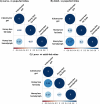The proteomic content of Varroa destructor gut varies according to the developmental stage of its host
- PMID: 39774526
- PMCID: PMC11723617
- DOI: 10.1371/journal.ppat.1012802
The proteomic content of Varroa destructor gut varies according to the developmental stage of its host
Abstract
The nutritional physiology of parasites is often overlooked although it is at the basis of host-parasite interactions. In the case of Varroa destructor, one of the major pests of the Western honey bee Apis mellifera, the nature of molecules and tissues ingested by the parasite is still not completely understood. Here, the V. destructor feeding biology was explored through artificial feeding, dissection of the mite's gut and proteomic analyses. More specifically, the proteome of guts extracted from starved mites and honey bee-fed mites was compared to highlight both the parasite proteins likely involved in food processing and the honey bee proteins actually ingested by the mite. We could identify 25 V. destructor candidate proteins likely involved in the parasite digestion. As the host developmental stages infested by the mite are diverse, we also focused on the identity and on the origin of honey bee proteins ingested by the mite when it feeds on larvae, pupae or adults. We highlighted profiles of consumed honey bee proteins and their variations throughout the V. destructor life cycle. These variations matched the ones observed in the honey bee hemolymph, showing that this tissue is an important part of the mite's diet. Based on the variations of abundance of the most consumed honey bee proteins and on their functions, the potential implication of these key candidate nutrients in V. destructor reproduction is also discussed.
Copyright: © 2024 Piou et al. This is an open access article distributed under the terms of the Creative Commons Attribution License, which permits unrestricted use, distribution, and reproduction in any medium, provided the original author and source are credited.
Conflict of interest statement
The authors have declared that no competing interests exist.
Figures






Similar articles
-
Honey Bee Larval Hemolymph as a Source of Key Nutrients and Proteins Offers a Promising Medium for Varroa destructor Artificial Rearing.Int J Mol Sci. 2023 Aug 4;24(15):12443. doi: 10.3390/ijms241512443. Int J Mol Sci. 2023. PMID: 37569818 Free PMC article.
-
Larval Exposure to Parasitic Varroa destructor Mites Triggers Specific Immune Responses in Different Honey Bee Castes and Species.Mol Cell Proteomics. 2022 Aug;21(8):100257. doi: 10.1016/j.mcpro.2022.100257. Epub 2022 Jun 13. Mol Cell Proteomics. 2022. PMID: 35710070 Free PMC article.
-
Immunogene and viral transcript dynamics during parasitic Varroa destructor mite infection of developing honey bee (Apis mellifera) pupae.J Exp Biol. 2014 May 15;217(Pt 10):1710-8. doi: 10.1242/jeb.097766. J Exp Biol. 2014. PMID: 24829325
-
Understanding the Enemy: A Review of the Genetics, Behavior and Chemical Ecology of Varroa destructor, the Parasitic Mite of Apis mellifera.J Insect Sci. 2022 Jan 1;22(1):18. doi: 10.1093/jisesa/ieab101. J Insect Sci. 2022. PMID: 35137134 Free PMC article. Review.
-
Ecology of Varroa destructor, the Major Ectoparasite of the Western Honey Bee, Apis mellifera.Annu Rev Entomol. 2016;61:417-32. doi: 10.1146/annurev-ento-010715-023731. Epub 2015 Dec 14. Annu Rev Entomol. 2016. PMID: 26667378 Review.
Cited by
-
Parasitic Mites of Honey Bees (Apis Spp.): A Detailed Review of Varroa destructor in Parasitism, Pathogen Transmission and its Management.Acta Parasitol. 2025 Aug 19;70(5):184. doi: 10.1007/s11686-025-01124-w. Acta Parasitol. 2025. PMID: 40828485 Review.
References
-
- Krasnov BR, Sarfati M, Arakelyan MS, Khokhlova IS, Burdelova NV, Degen AA. Host specificity and foraging efficiency in blood-sucking parasite: Feeding patterns of the flea Parapulex chephrenis on two species of desert rodents. Parasitol Res. 2003;90: 393–399. doi: 10.1007/s00436-003-0873-y - DOI - PubMed
MeSH terms
Substances
LinkOut - more resources
Full Text Sources
Research Materials

